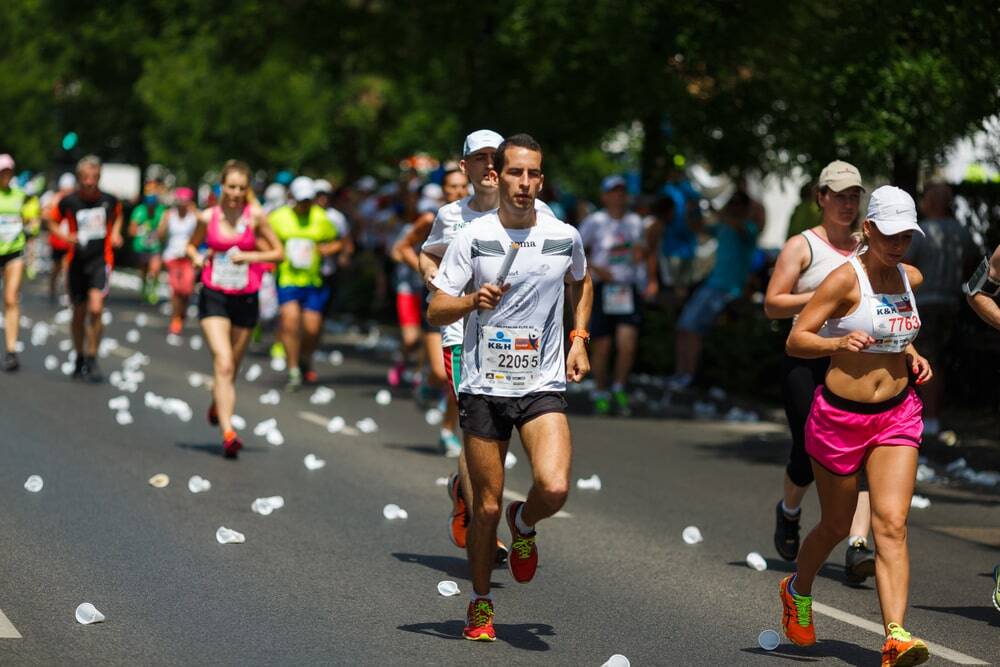Long-distance relay races have been around for decades, but demand has recently boomed. With the popularity of marathons on an unstoppable upward trajectory, more and more major events across the world are looking to add the marathon relay to their events.
The experience of running a marathon at a major event truly is unforgettable. These marathon relays offer runners the chance to feel all of the feelings and emotions that come on race day, without having to complete the full 26.2-mile course.
In this article, we will take a closer look at what exactly a marathon relay race is, how it works, the rules involved, and everything else that you may need to know before signing up for one.
What Is A Marathon Relay Race?
A marathon relay race is a 26.2-mile or 42.195-kilometer race which is run in the relay format. This means that the race is run in teams who will take turns to run different segments or legs of the race. This means that instead of running the whole marathon distance, runners will only have to run a smaller portion of it.
As with any relay race, the marathon relay involves passing either a baton or timing chip between different members of the team at the specific transition points on the course. This format not only helps to make the marathon distance more accessible, but it also combines endurance exercise with strategic thinking and team-based participation.
What Are The Benefits Of A Marathon Relay Race?
Teamwork - One of the main benefits of taking part in marathon relay races is the teamwork and camaraderie that is involved with the event. Typical marathons are typically very lonely and because of that, very tough. So having the motivation that comes with a team can help to make the training and the race day so much easier.
Accountability - Another brilliant benefit of marathon relay races is the accountability that comes with them. You are no longer just running for yourself, you are running for every member of your team. This pressure can help to keep you accountable and make sure that you do all the training and preparation that you need to.
Fun - Marathon running is typically a rigorous activity. However, when you cut that distance down drastically and share it with a group of close friends, the day becomes a whole lot more fun. This also makes the whole running experience so much more enjoyable and so much less daunting. Plus if you're travelling abroad to attend the race, the reduced distance means you'll have life in your legs for exploring afterwards!
Charity Fundraising - Running these huge events is made so much more meaningful by running for a cause. When running and fundraising for a cause a group of individuals can collectively raise far more money than a single individual. Therefore every penny that you raise and mile that you run will mean more.
How Do Marathon Relay Races Work?

Team Size:
Most marathon relay teams typically consist of between 4 - 6 runners. However, this number can vary depending on the event.
Distance:
The total distance of the race is 26.2 miles or 42.195 kilometres, but no runner will complete the full distance. The total distance will be split into different segments which each different runner will be responsible for.
Race Legs:
There is no set distance that race legs should cover. However, the length of the race leg will be dependent on the number of runners within a team.
Different runners can also run different lengths depending on their ability. So one runner may run 15k, whereas another runner may only run 5k.
Passing The Baton:
In between each leg, teams will have to pass either a baton or a timing chip within the designated transition zone.
When making the handoff, runners must be within the transition zone. The transition zone is where one runner will finish their part of the race and the next runner will start their portion of the race.
Transition Zones:
Different transition zones will be set up along the course and runners must pass their batons or chips within these zones. If they do not stay within these zones or drop their baton/timing chip then they could be penalised.
Timekeeping:
The total time is calculated from the moment that the first runner sets off to the moment that the last runner crosses the finish line. All times will be tracked by official event organisers and will therefore be incredibly accurate.
What Is The Best Strategy For A Marathon Relay Race?

While marathon relay races are predominately about enjoying yourselves and having fun, you do ultimately want to run as fast as possible. However, with all of the added logistics that go into a marathon relay event, having a thought-out strategy for race day can be extremely important in making sure they are as quick as possible.
Below we have listed a few strategy tips to ensure that you and your team have the very best chance of getting a fast time in your marathon relay.
Know Your Team’s Strengths & Weaknesses
One of the most important factors to take into account when putting together a marathon relay race day strategy is your team's strengths, weaknesses, and abilities. Not only will this help you to properly delegate leg lengths and paces, but it will also allow you to set realistic expectations for everyone in your team.
We recommend giving your strongest runners the longest legs and having them start and end the race. This is because a strong start and a strong finish can help to take the pressure off the middle legs and thus allow your ‘weaker’ runners to have the more enjoyable and less pressured legs.
Having your strongest runner finish the race is always recommended as they can push themselves hard to try and secure the strongest finish for the team. This therefore gives you the best possible chance of achieving a fast time for your run.
Have Your Pacing Nailed
Another very important factor to remember regarding marathon relay races is pacing. Too many runners neglect pacing during these events. This is because they think that the race is far easier as the load is shared amongst their team. However, pacing yourself according to your ability is still incredibly important for ensuring a strong race.
As a team, you should have a time in mind for your race. With this time in mind, you should work out each team member's average pace goal needed to hit this race time. When setting each individual pace goal, it is important to make sure that the paces are realistic and are not pushing your runners too hard.
Practise Handoffs
One of the hardest parts about a marathon relay race is the baton/timing chip handoff. While this may seem like such a simple and minuscule task, not having it nailed down can be very costly. This is because any handover mistakes can result in your team receiving timing penalties which can add massively to your finishing race time.
During your training, you should ensure that you are constantly practising passing over the baton. This will help to make the race day transitions as smooth as possible and help you to avoid any unwanted penalties.
Have Warm Up & Warm Down Routines
This tip is less about strategy and more about making sure that each of your runners can perform at their best on race day. Before each leg of the race, it is important to make sure that each runner in your team is properly warmed up. This is because a good warm-up can help to loosen the joints, improve the blood flow to your muscles, and help prevent any injuries.
Struggling to come up with a warm-up routine? We are lucky enough to partner with the running powerhouse Runna who provides tailored training plans and support, whatever your running goals.. Check out the warm-up routines of some of Runna’s top coaches here:
Coach Beth's steady warm-up:
Coach Beth's hard warm-up:
Coach Ben’s hard warm-up:
How To Find Marathon Relay Events?
The number of marathon relay race events across the globe has in recent years grown dramatically. Here at realbuzz, we partner with Run Rome The Marathon who have added a marathon relay race to their event for March 2025. So if you have a group of friends who would love to take turns running the historic streets of Rome, enter now and secure your place.
At realbuzz, our goal is not just to help people take part in incredible events across the world, we also want to make each of our runner's miles mean more. That is why we provide guaranteed entry to huge global running events and all you have to do is raise money for incredible causes. We are incredibly proud to have raised over £1 billion for incredible causes so far, but we are only just getting started.


